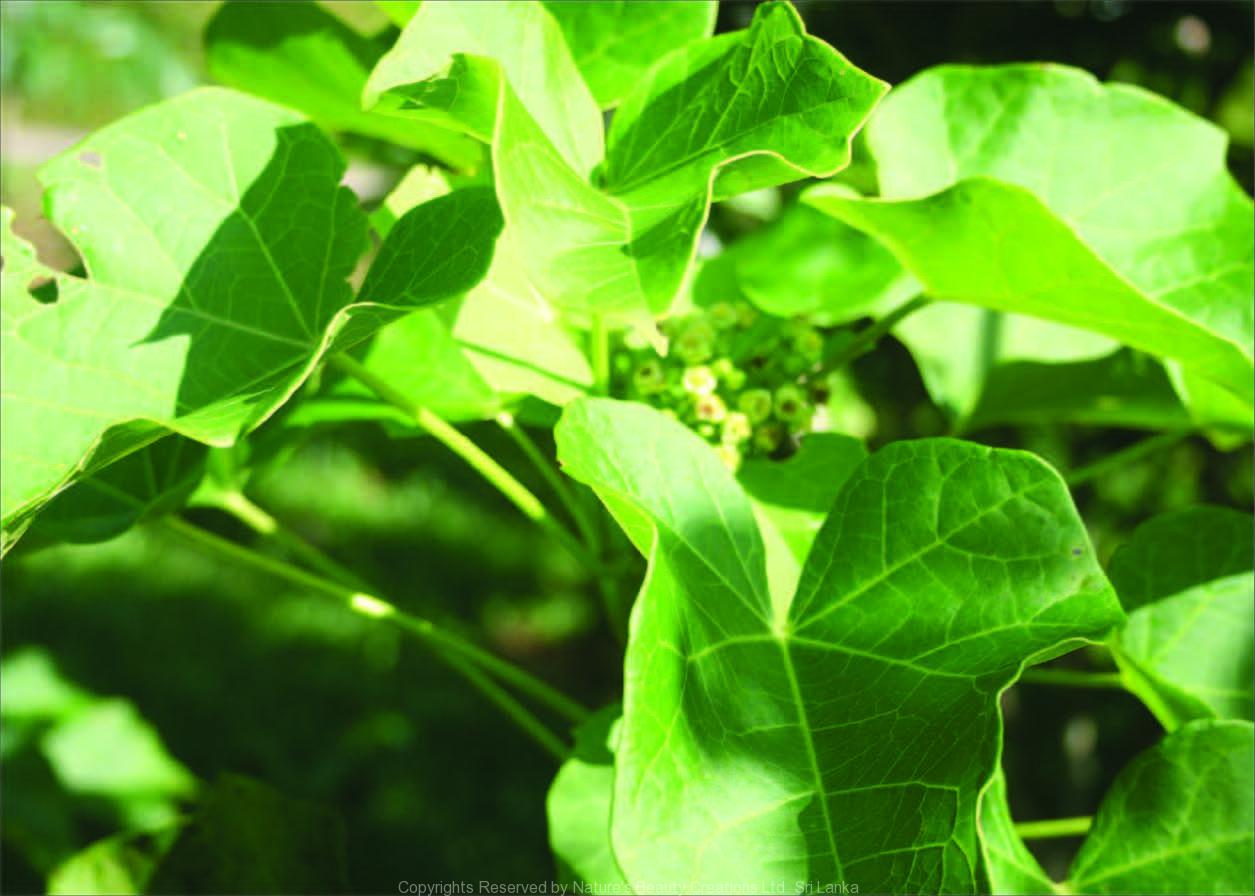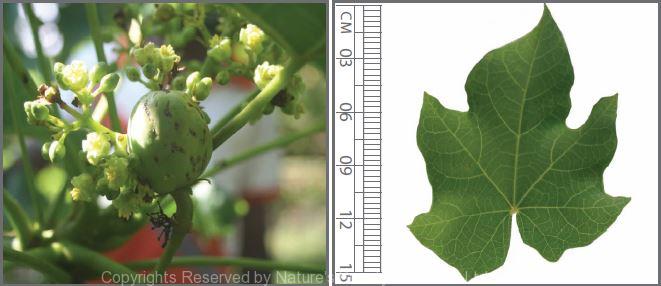

Traditional Knowledge
Useful plant parts :
Stem, leaf, bark and latex
Uses in traditional medicine :
- Pencil size diameter sticks are used to make a tooth brush for mouth sanitation
- Crushed leaves are used to treat wounds to arrest bleeding
- Stem is used to strengthen gums and cures gum boils
- Poultice made of bark is applied for sprains, dislocations and toothache
- Latex is used to treat sores and ulcers
Scientific Research
Chemical constituents:
Stigmasterol and β-sitosterol, dimer of a triterpene alcohol, flavonoidal glycosides from leaves; cyclic octapeptide: curcacycline A and proteolytic enzyme: curcain from latex; diterpenes: curcusones A–D and spirocurcasone, oleanolic acid derivatives, heudelotinone, jatrogrossidione derivatives and anthraquinone derivatives from plant; coumarins: tomentin, isoscopoletin, phenolic compounds: coniferaldehyde, benzaldehyde derivatives, vanillic acid and stilbene derivatives from stem; protein: curcin from endosperm
Bioactivity :
Methanol extract of roots: antidiarrhoeal, anti-inflammatory; protein extract: mosquito larvicidal; whole latex: coagulant; diluted latex: anticoagulant; methanol extract of leaf: antimicrobial; curcin: antitumor; stem bark extract: antioxidative
Clinical:
References : Berg, A. J. J. V. D. et al., (1995), Curcacycline A — a novel cyclic octapeptide isolated from the latex of Jatropha curcas L., FEBS Letters, 358(3), 215-218. Chanthakan, N. et al., (2012), Larvicidal activity of a toxin from the seeds of Jatropha curcas Linn. against Aedes aegypti Linn. and Culex quinquefasciatus Say, Trop Biomed, 29(2), 286-96. Chianese, G. et al., (2011), Spirocurcasone, a diterpenoid with a novel carbon skeleton from Jatropha curcas, Org Lett, 13(2), 316-9. Devappa, R. K. et al., (2011), Jatropha diterpenes: a review, Journal of american oil chemist’s society, 88(3), 301-322. Igbinosa, O. O. et al., (2011), Polyphenolic Contents and Antioxidant Potential of Stem Bark Extracts from Jatropha curcas (Linn), Int J Mol Sci, 12(5), 2958-71. Mujumdar, A. M. et al., (2001), Antidiarrhoeal effect of an isolated fraction (JC) of Jatropa curcas roots in mice, Journal of natural remadies, 1(2), 89-93. Mujumdar, A. M. and Misar, A. V., (2004), Anti-inflammatory activity of Jatropha curcas roots in mice and rats, J Ethnopharmacol, 90(1), 11-5. Nath, L. K. and Dutta, S. K., (1991), Extraction and purification of curcain, a protease from the latex of Jatropha curcas Linn, J Pharm Pharmacol, 43(2), 111-4. Osoniyi, O. and Onajobi, F., (2003), Coagulant and anticoagulant activities in Jatropha curcas latex, J Ethnopharmacol, 89(1), 101-5 Ravindranath, N. et al., (2004), New lathyrane and podocarpane diterpenoids from Jatropha curcas, Chem Pharm Bull, 52(5), 608-11. Villasenor, I. M. and Carino, F. A., (2011), Antimicrobial activity of new phorbins from Jatropha curcas Linn. (Euphorbiaceae) leaves, Z Naturforsch C, 66(9-10), 441-6. Xu, J. J. and Tan, N. H., (2012), Phenolic compounds from Jatropha curcas, Zhongguo Zhong Yao Za Zhi, 37(20), 3074-7. Zhao, Q. et al., (2012), The effect of curcin from Jatropha curcas on apoptosis of mouse sarcoma-180 cells, Fitoterapia, 83(5), 849-52. Khafagy, S. M. et al., (1977), Phytochemical study of Jatropha curcas, Planta Med, 31(3), 274-277.
Copyrights Reserved By
Natures Beauty Creations



